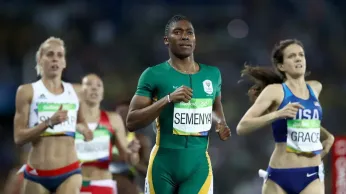
Sep 22
World Athletics Report Reveals Dozens of DSD Athletes Finalists Under New Sex Verification Rules
READ TIME: 4 MIN.
A World Athletics panel has revealed that between 50 and 60 athletes, who would not meet the current sex verification standards, have competed as finalists in women's track and field events at major championships since 2000. The announcement, made by Dr. Stéphane Bermon, head of health and sciences for the international governing body, comes as the organization faces ongoing scrutiny over its policies regarding athletes with differences in sexual development (DSD) and transgender competitors .
According to Dr. Bermon, data collected from 2000 to 2023 identified 135 finalists with DSD in various international competitions, with an estimated 50 to 60 appearing as finalists in more than one event. These findings were presented during a recent panel in Tokyo, where the necessity and implications of sex verification testing in elite women's athletics were discussed .
World Athletics defines DSD as a group of rare conditions involving genes, hormones, and reproductive organs, which can result in a spectrum of sex characteristics. The organization’s latest recommendations propose comprehensive sex screening protocols for all athletes seeking to compete in the female category at the elite level, including SRY gene testing and, if required, testosterone level assessments. The stated aim is to ensure "fairness and integrity" in the sport while upholding the dignity and privacy of all athletes .
Attempts to regulate the participation of athletes with DSD are not new in track and field. Since the 1930s, various forms of sex verification have been employed, evolving alongside scientific and societal understanding. The current debate intensified notably after South African middle-distance runner Caster Semenya’s rise to prominence. Semenya, who is intersex and has naturally elevated testosterone levels, has faced repeated scrutiny and legal battles to remain eligible for women's events .
In 2019, Semenya lost a landmark appeal at the Court of Arbitration for Sport (CAS), upholding regulations that require women with certain DSDs to lower their testosterone levels in order to compete. The European Court of Human Rights later found that Switzerland had violated Semenya’s right to non-discrimination, but this did not overturn the World Athletics regulations .
The 2023 World Athletics policy further excluded transgender women who have experienced male puberty from competing in the female category, citing competitive fairness . The organization maintains that it does not question gender identity and is committed to respecting the dignity and privacy of all athletes. However, critics argue that the new rules disproportionately impact intersex and transgender athletes and raise serious questions about human rights and medical ethics .
The release of these findings has reignited debate throughout the global sports and LGBTQ+ communities. Advocates for inclusion emphasize that sex and gender exist on a spectrum, and that rigid binary categories in sport fail to accommodate the complexity of human biology and lived experience. Many highlight the psychological and social harm caused by invasive testing, public scrutiny, and the potential exclusion of elite athletes who have trained for years .
Athletes affected by DSD regulations, such as Caster Semenya and Namibia’s Christine Mboma, have become symbols of this struggle. Both have won medals at the Olympic Games, only to face subsequent exclusion or forced medical interventions. Human rights organizations, including the United Nations, have warned that such policies may constitute discrimination and violate the rights to privacy, dignity, and bodily autonomy .
World Athletics argues that athletes with certain DSDs, specifically those with XY chromosomes and natural testosterone levels in the male range, may have an unfair advantage in some events. However, scientific consensus on the extent of this advantage, and how it should be regulated, remains contested. Recent studies have pointed out inconsistencies in how testosterone’s impact on performance is applied across different events, and some experts question whether the policies are evidence-based or reflect broader societal biases .
The organization’s report recommends merging DSD and transgender regulations and establishing a pre-clearance requirement for all competitors in the female category at the elite level. Critics, including numerous LGBTQ+ advocacy groups, stress that such measures must be implemented with extreme care to avoid further stigmatization or marginalization of gender-diverse athletes .
As World Athletics prepares for further consultation and possible regulatory changes, the global sports community faces critical questions about how to balance competitive fairness with inclusion and human rights. The emergence of new data on DSD athletes highlights the urgent need for nuanced, science-based, and compassionate approaches that protect all athletes’ dignity and well-being.
Athletes, advocates, and policymakers continue to call for greater transparency, broader consultation with affected communities, and the adoption of non-invasive, respectful testing methods. Some have urged the creation of additional competition categories or revised eligibility frameworks, while others argue for the abolition of sex verification altogether, in favor of open and inclusive participation.
Regardless of the path forward, the findings disclosed by World Athletics are certain to shape the ongoing debate over gender, biology, and equity in elite sport. For many in the LGBTQ+ community, the stakes are not merely athletic, but deeply personal—touching on identity, human rights, and the right to compete on one’s own terms.






